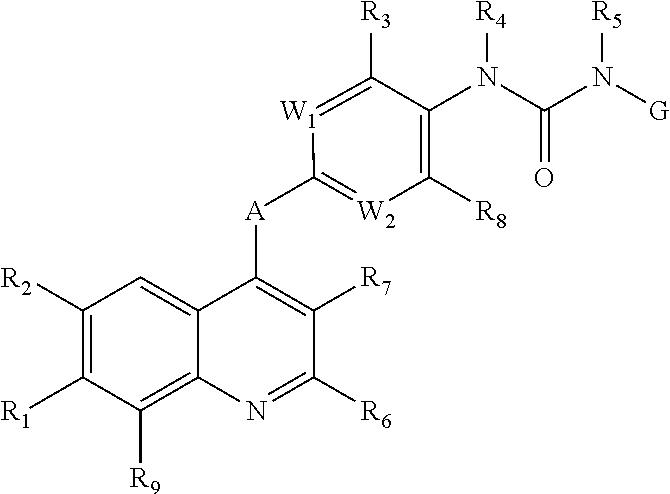Quinoline compound, preparation method and medical use therefor
- Summary
- Abstract
- Description
- Claims
- Application Information
AI Technical Summary
Benefits of technology
Problems solved by technology
Method used
Image
Examples
example 1
Preparation of 4-{4-[3-(5-tert-butyl-isoxazol-3-yl)-ureido]-phenoxy}-7-methoxyquinolin-6-carboxamide
[0310]
Step 1: Preparation of 4-(4-aminophenoxy)-7-methoxy-quinolin-6-carboxamide
[0311]At room temperature, 4-aminophenol (purchased from TCI) (461 mg, 4.22 mmol) was dissolved in 10 ml of DMSO, and sodium hydroxide (340 mg, 8.44 mmol) was added. The mixture was stirred at room temperature for 30 min, then 4-chloro-7-methoxy-quinolin-6-carboxamide (500 mg, 2.11 mmol) (purchased from Shanghai Titan) was added. The mixture was heated to 100° C. and reacted for 1 hour. The reaction solution was cooled to room temperature, slowly poured into water, and extracted with ethyl acetate (80 ml×3). The organic phase was washed twice with saturated NaCl solution, dried over anhydrous sodium sulfate, filtered and the filtrate was concentrated under reduced pressure. The residues were purified via column chromatography (eluent: dichloromethane / methanol) to give 270 mg yellow solid.
Step 2: Preparatio...
example 2
Preparation of 4-{4-[3-(5-tert-butyl-isoxazol-3-yl)-ureido]-3-chloro-phenoxy}-7-methoxyquinolin-6-carboxamide (Compound 2)
[0316]
[0317]The preparation method was the same as Example 1, except that 4-amino-3-chlorophenol hydrochloride (TCI) was used instead of 4-aminophenol in Step 1 to give 4-{4-[3-(5-tert-butyl-isoxazol-3-yl)-ureido]-3-chloro-phenoxy}-7-methoxyquinolin-6-carboxamide.
[0318]1HNMR (DMSO-d6, 400M Hz) δ: 10.24 (s, 1H), 8.79 (s, 1H), 8.69 (s, 1H), 8.69-8.70 (d, 1H), 8.67 (s, 1H), 8.27-8.29 (d, 1H), 7.86 (br, 1H), 7.74 (br, 1H), 7.59-7.60 (d, 1H), 7.53 (s, 1H), 7.30-7.33 (dd, 1H), 6.57-6.59 (d, 1H), 6.48 (s, 1H), 4.07 (s, 3H), 1.31 (s, 9H).
[0319]LC-MS: ESI 510.1 (M+H)+.
example 3
Preparation of 4-{3-bromo-4-[3-(5-tert-butyl-isoxazol-3-yl)-ureido]-phenoxy}-7-methoxyquinolin-6-carboxamide (Compound 3)
[0320]
[0321]The preparation method was the same as Example 1, except that 4-amino-3-bromophenol (TCI) was used instead of 4-aminophenol in Step 1 to give 4-{3-bromo-4-[3-(5-tert-butyl-isoxazol-3-yl)-ureido]-phenoxy}-7-methoxyquinolin-6-carboxamide.
[0322]1HNMR (DMSO-d6, 400 MHz) δ: 10.31 (s, 1H), 8.64-8.70 (m, 3H), 8.18-8.20 (d, 1H), 7.87 (br, 1H), 7.75 (br, 1H), 7.71-7.72 (d, 1H), 7.54 (s, 1H), 7.34-7.37 (dd, 1H), 6.57-6.59 (d, 1H), 6.47 (s, 1H), 4.04 (s, 3H), 1.31 (s, 9H).
[0323]LC-MS: ESI 555.0 (M+H)+.
PUM
| Property | Measurement | Unit |
|---|---|---|
| Molar density | aaaaa | aaaaa |
| Molar density | aaaaa | aaaaa |
| Molar density | aaaaa | aaaaa |
Abstract
Description
Claims
Application Information
 Login to View More
Login to View More - R&D
- Intellectual Property
- Life Sciences
- Materials
- Tech Scout
- Unparalleled Data Quality
- Higher Quality Content
- 60% Fewer Hallucinations
Browse by: Latest US Patents, China's latest patents, Technical Efficacy Thesaurus, Application Domain, Technology Topic, Popular Technical Reports.
© 2025 PatSnap. All rights reserved.Legal|Privacy policy|Modern Slavery Act Transparency Statement|Sitemap|About US| Contact US: help@patsnap.com



